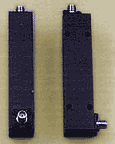
Iso Filters
- CAN APPLY TO ANY CATALOG STANDARD FILTER
- GOOD OUT OF PASSBAND VSWR
- LOW- LOSS IMPACT

As implied, an Iso- filter is the combination of an isolator and a filter. The main advantage of the Iso-filter is in how the filter itself works. Dual Isolator FiltersWhen a signal hits the input port of a filter one of two things can happen to the energy; it can pass through (transmission) or it can be reflected (return loss of VSWR). Although the overall performance of a filter can be set by the number of sections and the Q of each size of each of the sections, almost all of its selectivity is due to reflectivity of the device outside of its passband.
What this means is the return loss or VSWR is very bad outside of the passband. Therefore any signals in this frequency range will be reflected back to the generating source. In most cases, this is not a problem; but, if it is, there are a limited number of solutions.
- The most simple and cost effective solution is the use of an attenuator pad. The worse case return loss will be twice the loss value of the attenuator pad. For example a 3db pad will have a minimum of 6 db return loss. unfortunately, not all applications can afford the extra insertion loss.
- The next simplest solution is an iso-filter. The isolator will typically be less than 1 db of loss with a rejection of better than 20 db. These typically cost more than the attenuator pads.
- The third alternative is a terminated complimentary multiplexer scheme. These have the least amount of effect on the insertion loss, however they are very costly custom items. This usually relates to long lead times.